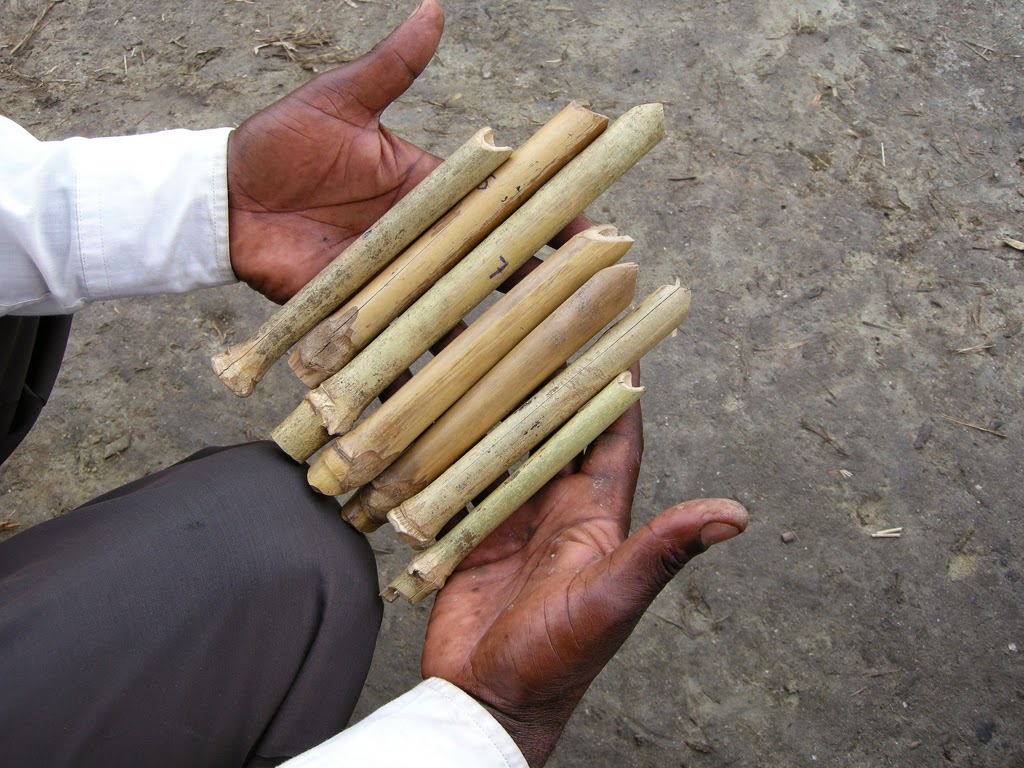David and l set off at 12.30 for the
coronation having lunch, fish and chips in town first. Then we got to sit on white plastic chairs in
this big field. There was some dancing by children but as David said was not
truly authentic – ‘T’ shirts and shorts and grass skirts with a strip of bark
cloth around the head. Later there were
some drummers who looked more authentic wearing grass skirts and colobus monkey
skins around their heads and bells on one leg, but it was difficult to get a
good view as everyone got up and joined them dancing around them and the media
were encircling them too, so could not get close enough. I had a little girl who kept pestering me for
money or bread, although smartly dressed and the father was only two rows in
front of us. There was some older people
dressed in skins with some gourds hanging around their necks and the old guy
had a blanket of bark cloth slung around him too. This was the 48th. Coronation of
the Bakonjo king since Independence in 1962.
Then we had a quick soda at the Hotel
Margarita where there were some other muzungos having a meeting by the look of
it. Lovely flowers as we drove up the
driveway but the hotel itself was rather sparse of decoration – no plants in
pots or artwork on the walls.
Then we went to Kiwa Heritage Centre, which
had a curative hot spring. They had a
fish farm to generate money for the museum. They also had an old house
reconstructed using straw and inside they had two fires – the first in the
woman’s half for cooking, etc. nearest the door, and the other quarters were
the bedroom where the daughters slept and the other quarter was for the boys
and men to sit around the other fire and resolve family business – whilst
drinking the local brew which was fermenting bananas with sorghum. They had
other gourds, which were used for enemas and had a long stem to put up the anus
with a hole at the end. There were some
flutes in a basket and seven of these were played at womens funerals. They
would also be played for a NON-circumcised man on death as it signified that he
was like a woman! (Similar to the Koma erected
to uninitiated Gohu members).
The xylophone was played for invoking the god
Katisamba (the invisible spirit of the mountain) and played both sides. To get the right pitch/note but also carve a
bit of wood away until it makes the right sound.
One of the boys was making a model of a goat
using cassava flour and water with the earth, which was grey in colour and
looked a bit sandy. This ‘museum’ was
made on swampland and had a lot of stagnant streams running through it – lethal
for malaria! The hot spring was truly
hot like a hot bath which people cam to bath in for recreation as well as cure.
I paid 6000/- here for this info. 30000/- for lunch for David and me, and 5000/-
for two sodas later. David told me that
Kule Walyuba Sylvester, the director here, was a crook – he resold land that David had bought and
started to build on! Kisobulu Ericana
was the main informant here – guide to the museum. Saturday Leo was the young boy playing the
xylophone along with Kisobulu. Saturday
Leo was the boy also making the goat sculpture.
Then on the way home we stopped at a brick kin
to take a photo – it was getting dark by now though. The kilns are fired for three days a fire is
made in both holes and blocked up and the whole structure caked with earth and
straw mixture – maybe even cow dung?
After photographing David with objects and
writing bear minimum on the questionnaire we will pour one side of the rubber
mould and at 11.30 set off to see the witch doctor near Ibanda.











No comments:
Post a Comment